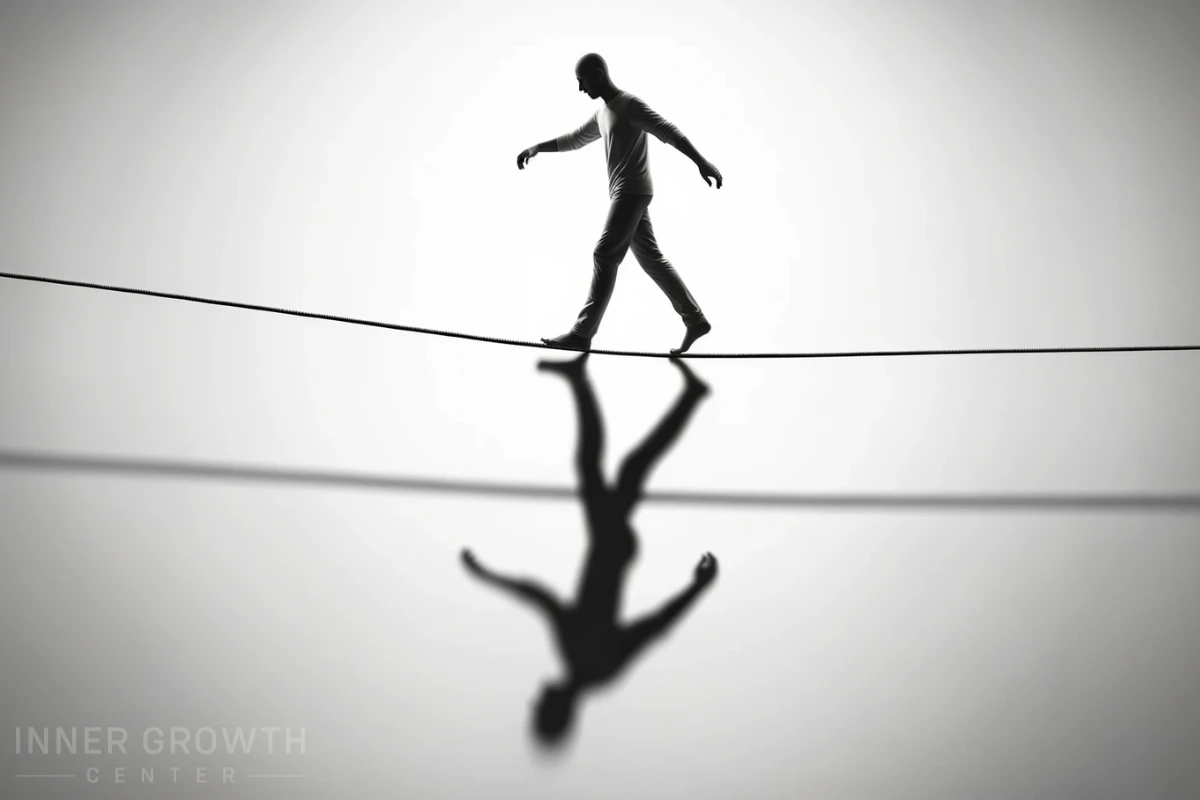Are there parts of yourself you don’t quite understand or accept?
An inner darkness you fear?
This is your shadow self.
Exploring your shadow is a powerful path to spiritual growth and healing.
Shadow work means shining a light on the hidden aspects of your psyche. Facing the traits, emotions, and impulses you’ve learned to see as “bad” or shameful.
Why?
Because embracing your full humanity, light and dark, can lead to transformation and self-acceptance.
Here we’ll explore what the shadow is, how it forms, and why facing it is a key step in your personal evolution.
You’ll discover practical tools for shadow work and how to navigate the challenges that arise.
Above all, we invite you to approach your shadow with curiosity and compassion.
Are you ready to meet your whole self?
Let’s step bravely into the shadows and unveil your most authentic, powerful self.
What is the “shadow” and why should you care?
Your shadow is made up of the parts of yourself that you’ve hidden away, rejected, or denied. These are the traits, emotions, and impulses that you believe are unacceptable or shameful. Maybe you learned to suppress your anger, hide your sensitivity, or silence your creativity.
But here’s the thing: Your shadow is a vital part of who you are. When you ignore or reject your shadow, you cut yourself off from your full potential. You limit your ability to know yourself deeply and to experience life fully.
Facing your shadow takes courage, but it’s worth it. By embracing your whole self, you can heal old wounds, break free from limiting patterns, and tap into a greater sense of energy and aliveness. Shadow work is an invitation to reclaim the lost parts of yourself and step into your authentic power.
How does the shadow develop?

We all have a shadow, and it starts forming early in life. As children, we learn from our families and society which traits and behaviors are acceptable and which are not. We may be taught that expressing anger is bad, that being sensitive is weak, or that shining too brightly is selfish.
To fit in and feel loved, we start to hide away the parts of ourselves that don’t match what’s expected of us. We create a persona, a mask we show to the world, while our shadow traits get pushed into the unconscious.
The thing is, these shadow traits don’t go away just because we ignore them. They continue to influence us from behind the scenes, often sabotaging our relationships, goals, and sense of self-worth. Until we bring awareness to our shadows, we remain unconsciously controlled by them.
What happens when you ignore your shadow?
Suppressing or denying your shadow comes at a cost.
When you reject parts of yourself, you limit your full potential. You cut yourself off from the depth and richness of your being.
Unacknowledged shadows often leak out in destructive ways. They can manifest as self-sabotage, toxic relationship patterns, or a nagging sense that something is wrong with you.
For example, if you deny your anger, it might come out as passive-aggressive behavior or explosive outbursts. If you hide your sensitivity, you might struggle with intimacy and push people away.
Ignoring your shadow can also lead to projection. You may judge or criticize in others the very traits you’ve disowned in yourself.
The result? A sense of inner conflict and disconnection from your authentic self.
5 signs you need to work with your shadow

How do you know if shadow work could help you? Here are some signs to look out for:
1. You feel triggered or reactive in certain situations
Do you find yourself getting easily triggered or reactive, without fully understanding why? This could be a sign that your shadow is being activated. When we suppress parts of ourselves, they can get triggered by external events or people that remind us of our hidden traits.
For example, if you’ve disowned your own anger, you might feel instantly irritated when someone else expresses frustration. Shadow work can help you understand and heal these triggers, so you can respond more consciously.
2. You keep repeating painful patterns
Do you notice yourself repeating the same painful patterns in relationships, work, or other areas of life? This could be a sign that your shadow is running the show behind the scenes.
We often unconsciously recreate situations that mirror our unresolved shadow issues. For instance, if you have a hidden belief that you’re unlovable, you might keep attracting partners who are unavailable or rejecting. Shadow work can help you break these cycles by bringing awareness to your unconscious patterns.
3. There are parts of yourself you’re ashamed of
Are there traits, feelings, or behaviors you try to hide from others or yourself? Shame is often a signal that your shadow needs attention.
We all have aspects of ourselves that we’ve learned to see as unacceptable. But the more we try to push these parts away, the more they tend to control us. Shadow work invites you to bring compassion and acceptance to your whole self, so you can transform shame into self-integration.
4. You struggle with a harsh inner critic
Does your inner dialogue often feel like a cruel, unrelenting critic? A harsh inner voice can be a sign that you’ve internalized negative beliefs about yourself.
These critical thoughts often stem from parts of ourselves we’ve rejected. Through shadow work, you can start to understand the origins of your inner critic and develop a more compassionate, nurturing inner relationship.
5. You feel disconnected from your true self
Do you feel like you’re not living as your authentic self? Like you’re wearing a mask or playing a role that doesn’t quite fit? This sense of disconnection can be a sign that you’ve lost touch with your shadow.
When we deny parts of ourselves, we limit our capacity for genuine self-expression. We may feel like we’re living someone else’s life, rather than embodying our true desires and essence. Shadow work can help you reclaim the lost parts of yourself, so you can show up more fully and authentically in the world.
Practical techniques for exploring and integrating your shadow

Shadow work is an ongoing process that you can incorporate into your daily life. Here are some practical techniques to help you explore and integrate your shadow:
- Observe your emotions and triggers: Start by paying attention to your emotional reactions, especially the ones that feel intense or uncomfortable. Notice what triggers you in others – these are often clues to your own shadow aspects. Rather than pushing these feelings away, observe them with curiosity and non-judgment.
- Keep a shadow journal: Writing is a powerful tool for processing your shadow work experiences. Use a journal to freely express your thoughts, feelings, and insights without censorship. As you write, look for themes or patterns that emerge. You can also use your journal to dialogue with different parts of yourself, including your shadow.
- Practice self-compassion: As you acknowledge your shadow, you may feel shame, guilt, or self-judgment. Meet these feelings with self-compassion. Treat yourself with the same kindness and understanding you’d offer a good friend. Remember, having a shadow is part of being human – it doesn’t make you bad or wrong.
- Find healthy outlets for shadow energies: Once you’ve recognized a shadow trait, look for responsible ways to express or embody it. If you’ve been suppressing your assertiveness, practice speaking up for yourself. If you’ve been denying your creativity, make time for artistic activities. Find conscious outlets for your shadow energies.
- Embrace your wholeness: Celebrate the full spectrum of who you are, light and dark included. Embracing your humanity in all its shades is a powerful act of self-love. As you integrate your shadow, you may find a greater sense of authenticity and self-acceptance.
Remember, shadow work is a deeply personal journey. Honor your own pace and process. With time and practice, you can learn to explore and integrate your shadow in a way that feels authentic and empowering for you.
When to seek support for shadow work

While shadow work is a deeply personal journey, you don’t have to navigate it alone. There may be times when you need extra support or guidance, especially if you’re working with trauma or intense emotional material. Here are some signs that it might be helpful to seek support:
You feel overwhelmed or stuck
If you find yourself feeling overwhelmed, anxious, or depressed as you explore your shadow, it may be a sign that you need additional support. A therapist or counselor can provide a safe space to process difficult emotions and experiences.
Your shadows feel too big to face alone
Some shadow aspects, such as those rooted in childhood trauma or abuse, can feel too overwhelming to confront on your own. In these cases, it’s wise to seek the guidance of a qualified mental health professional who can help you work with your shadow safely and effectively.
You want a guide on your journey
Even if you don’t feel overwhelmed, you might benefit from the perspective and expertise of a therapist, coach, or spiritual teacher. Look for someone who has experience with shadow work and resonates with your values and goals.
Remember, seeking support is not a sign of weakness, but of strength and self-care. We all need help sometimes on the path of growth and healing.
5 Shadow work exercises for deep healing and growth you can practice right now

In addition to the practical techniques for exploring and integrating your shadow, there are specific exercises you can use to deepen your shadow work practice. These exercises can help you cultivate greater self-acceptance, connect with your inner wisdom, and facilitate profound healing and growth.
1. Acceptance and Inner Child Work
One powerful shadow work exercise is to practice unconditional acceptance of yourself, including your shadow aspects. You can do this by engaging in inner child work. Imagine your younger self who first learned to hide or suppress certain traits. Offer this child the acceptance, love, and understanding they needed. Let them know it’s safe to express their authentic self.
- Example exercise: Write a letter to your inner child, expressing the acceptance and love you wish they had received. Promise to honor and accept all parts of yourself moving forward.
2. Connecting with Your Higher Self
Your higher self is the part of you that is eternally wise, loving, and whole. Connecting with this aspect of yourself can provide guidance and support as you navigate your shadow work journey.
- Example exercise: In a quiet, meditative space, imagine a wise, loving presence within you. Ask this presence for guidance on working with a specific shadow trait. Listen for any insights or intuitions that arise.
3. Heart-Centered Shadow Dialogue
Another powerful exercise is to dialogue with your shadow aspects from a place of heart-centered compassion. Instead of trying to fix or change your shadow, this exercise invites you to listen deeply to what your shadow needs.
- Example exercise: Identify a shadow trait you’d like to work with. Imagine this trait as a separate being, and engage in a written dialogue with it. Ask your shadow what it needs from you to feel seen, heard, and accepted. Respond from a place of open-hearted compassion.
4. Embodiment Practices
Shadow work goes beyond just being a mental or emotional process – it can also involve the body. Embodiment practices can help you release stuck emotional energy and integrate shadow aspects on a somatic level.
- Example exercise: Notice where you feel a shadow emotion in your body. Breathe into this area and allow yourself to fully feel the sensation. You might try gently moving or stretching this part of your body to encourage the emotion to shift or release.
5. Mindful Shadow Awareness
This exercise involves bringing mindful attention to your shadow aspects as they arise in daily life. By catching shadow reactions in the moment, you create an opportunity to respond with conscious awareness.
- Example exercise: As you go about your day, notice when shadow aspects get triggered, such as a surge of anger or shame. Pause, take a deep breath, and silently acknowledge the triggered part of yourself. Then, ask: How can I respond in a way that honors my whole self?
Remember, these exercises are meant to complement, not replace, the practical techniques and everyday integration practices we discussed earlier. Trust your intuition on which exercises feel most resonant for you. With consistent practice, these exercises can help you cultivate a more loving, compassionate relationship with your whole self – shadow and light alike.
Reflections on the Shadow Work Journey
Doing shadow work takes courage and a willingness to face the hidden parts of ourselves. By shining a light on our shadows, we open the door to deep growth and self-acceptance.
The shadow is a natural part of the human psyche, not something to be ashamed of. Ignoring it can lead to painful patterns and disconnection from our authentic selves.
Shadow work involves bringing conscious awareness to our hidden traits and emotions. Practical techniques and deeper exercises can support this process. Seeking support from a therapist or guide can be invaluable.
Remember, shadow work is a lifelong journey. It requires patience and self-compassion.
By embracing your shadow, you reclaim your full humanity and step into a more authentic way of being.
You learn to love yourself wholly and show up more fully in your life.
Trust the wisdom of your journey.
Know that by facing your shadows with courage, you are taking a powerful step toward your highest potential.



